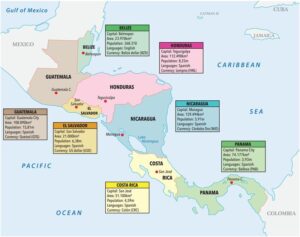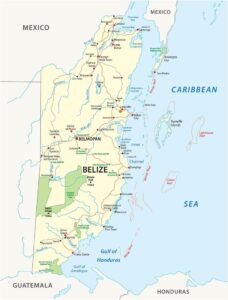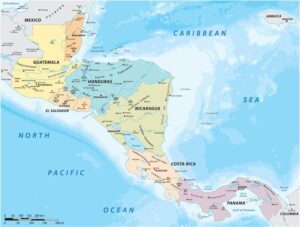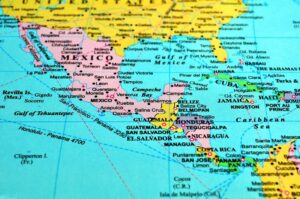Over the centuries, the territorial boundaries of Belize have been influenced by a rich and contentious historical narrative. You may find yourself pondering why the border between Belize and Guatemala appears as a dotted line on various maps; this visual representation reflects a deeply entrenched territorial dispute. This ongoing conflict traces its roots back to historical claims made by Guatemala, which has perpetually challenged Belize’s sovereignty since the latter achieved independence. The potential for international tension remains substantial, as both nations actively participate in diplomatic discussions aimed at resolving this boundary issue. Your journey into this geopolitical enigma uncovers the intricate challenges surrounding national borders in Central America, where colonial legacies and notions of territorial integrity continue to collide in potentially volatile ways.
Delving into the Historical Claims Behind the Belize-Guatemala Dispute
The enduring territorial conflict between Belize and Guatemala can be traced back to intricate historical and colonial legacies that shape their current relations. This dispute has its origins in the colonial era when territorial boundaries were often vaguely defined and subject to varied interpretations. The unresolved border issue has continued for centuries, resulting in persistent tension between these two neighbouring nations and impacting their diplomatic relations significantly. The historical context reveals how colonial decisions have far-reaching implications that echo into contemporary politics.

Investigating Guatemala’s Long-standing Territorial Claims Over Belize
Primarily, Guatemala has steadfastly upheld a historical assertion of territorial rights over Belize, which is rooted in the Spanish colonial administrative boundaries. It may surprise you to learn that Guatemala considers Belize part of its original territorial inheritance from the Spanish Empire, thereby contesting the modern borders that were delineated during the era of British colonial rule. This historical narrative continues to invigorate Guatemala’s claims and complicate the broader sovereignty issue, illustrating how historical contexts can influence present-day territorial disputes.
Unpacking the Implications of Historical Borders on Modern Diplomacy
Since the colonial period, these disputed boundaries have generated significant geopolitical challenges for both nations involved. You can observe how undefined border regions create potential for conflict and diplomatic tensions, which ultimately impact local communities and national sovereignty. Understanding the nature of the border dispute reveals complex layers of historical, legal, and territorial dynamics. The implications extend beyond mere geographical lines, encompassing economic, cultural, and security risks that are critical to both nations. The ongoing conflict carries substantial ramifications for regional stability, international law, and future negotiations between Belize and Guatemala, highlighting the intricate interplay between history and contemporary diplomacy.
Understanding the Significance of the Dotted Line on Maps
On numerous maps, you may come across a peculiar feature: a dotted boundary line separating Belize and Guatemala, which signifies a long-standing territorial dispute that has persisted for decades. This distinct cartographic representation indicates a complex geopolitical challenge, wherein the exact border remains undefined and contested. The dotted line serves as a symbol of the ongoing diplomatic tensions and the unresolved territorial claims that have long characterised the relationship between these two Central American nations.
International Recognition Amidst the Unresolved Border Dispute
Within the framework of international relations, Belize operates as a sovereign state with an established international presence; however, the disputed border with Guatemala introduces a nuanced geopolitical scenario. You might find it intriguing that while Belize achieved independence in 1981, Guatemala has historically challenged its territorial integrity. The dotted line not only signifies geographical uncertainty but also represents a continuing diplomatic negotiation that continually influences regional relations and perceptions, underscoring the complexities embedded within international borders.
Deciphering the Diplomatic Significance of the Dotted Line
Beyond its representation on maps, the dotted line serves as a powerful diplomatic symbol. You can interpret it as a visual manifestation of unresolved territorial claims, signalling to the international community the intricate negotiations between Belize and Guatemala. This unique border marking communicates the ongoing dialogue and the potential for a peaceful resolution to the conflict. However, the dotted line embodies more than just a cartographic curiosity; it represents a delicate diplomatic instrument that helps to avert possible military escalation while preserving an open channel for negotiations.
This line acts as a strategic buffer, enabling both nations to maintain diplomatic relations and work towards a possible resolution in the future. Its existence illustrates how international borders can be managed through peaceful means, showcasing a sophisticated approach to territorial disputes that prioritises dialogue over confrontation, thus promoting stability in the region.

Examining Key Conflicts and Diplomatic Agreements Between Belize and Guatemala
The territorial disputes between Belize and Guatemala are deeply entrenched in history and characterised by complex diplomatic tensions and unresolved boundary claims. You’ll discover that the ongoing disagreement revolves around competing interpretations of colonial-era treaties and the principle of territorial sovereignty. This dispute has far-reaching implications for both nations, involving potential land ownership challenges and regional geopolitical dynamics that continue to shape their relationship, underlining the importance of historical context in contemporary diplomacy.
Understanding the Impact of the 1859 Treaty and Subsequent Developments
Prior to the signing of the 1859 treaty between Britain and Guatemala, territorial boundaries within the region were ambiguous and hotly contested. It is crucial to understand that this agreement aimed to establish clear borders; yet, subsequent interpretations led to ongoing disputes that have persisted to this day. Guatemala consistently challenges the validity of the treaty, asserting that Britain did not fulfil certain commitments regarding infrastructure development, which has become a fundamental point of contention in their territorial disagreement and complicates ongoing diplomatic efforts.
International Court of Justice Involvement and Recent Diplomatic Initiatives
Recent diplomatic initiatives have focused on resolving the long-standing border dispute through international legal channels. You’ll note that both nations have consented to submit their case to the International Court of Justice (ICJ) for a binding resolution. This approach signifies a noteworthy step towards peaceful conflict resolution and indicates the potential for normalising bilateral relations between the two countries, demonstrating a commitment to addressing historical grievances through legal frameworks.
In addition to the ICJ proceedings, it is important to recognise the complex diplomatic negotiations that have taken place. The potential referendum in both countries to validate the ICJ’s decision represents a unique method for resolving territorial disputes. Your understanding of this process underscores the delicate diplomatic efforts to maintain regional stability and address historical territorial claims through peaceful, internationally recognised mechanisms, highlighting the critical role of public opinion in shaping diplomatic outcomes.
Assessing the Current Situation and Travel Considerations
Many travellers are intrigued by Belize’s unique border configuration with Guatemala. The ongoing territorial dispute has created a complex geopolitical landscape that significantly influences travel and border crossings. Despite the existing tensions, tourists continue to visit both countries, navigating the delicate diplomatic situation while considering international boundaries and local regulations that govern cross-border movements.
Essential Tips for Safely Navigating Border Crossings
When planning international travel to Belize, it’s essential to prepare meticulously and consider these important guidelines:
- Ensure you carry a valid passport and all necessary travel documents
- Check the current state of diplomatic relations before embarking on your journey to avoid complications
- Obtain appropriate travel insurance for your trip to ensure protection during your travels
- Stay informed about border crossing procedures and requirements to avoid misunderstandings
The most important aspect is to maintain awareness of your surroundings and respect local regulations, ensuring a smooth travel experience while navigating the complexities of international borders.
Community Perspectives and Local Sentiments Regarding the Dispute
Behind the border dispute lie deep-rooted historical tensions and intricate cultural dynamics. Communities situated near the border experience direct impacts from the dispute, with generational memories of conflict profoundly shaping their perspectives and attitudes. Residents often walk a tightrope between national pride and a desire for peaceful coexistence, which highlights the human element in this geopolitical issue and illustrates the complexities of identity in conflict zones.
Gaining Deeper Insights into Community Dynamics Along the Border
To truly understand the local perspective, you should explore the nuanced landscape of cultural identity. You’ll find that border communities have developed unique survival strategies, blending resilience with diplomatic pragmatism. Indigenous groups, in particular, play a critical role in maintaining cross-border relationships, often transcending official diplomatic tensions through grassroots connections and shared cultural experiences, fostering a sense of unity amid conflict and underscoring the importance of local agency in resolving broader geopolitical disputes.

Future Implications of the Belize-Guatemala Border Dispute
Despite the ongoing territorial dispute, there exists a potential for significant geopolitical shifts. The unresolved border issue between Belize and Guatemala continues to foster tension, with implications that could reshape diplomatic relations in Central America. You might observe that resolving this dispute could have profound impacts on regional stability, economic cooperation, and the international perceptions of both nations, highlighting the importance of collaborative efforts in promoting peace and mutual understanding.
Continuing Dialogue Between Belize and Guatemala for Resolution
Dialogue remains the primary mechanism for addressing the territorial disagreement. You will find that both countries have engaged in diplomatic negotiations, seeking peaceful resolutions through international platforms such as the Organization of American States (OAS). These conversations represent a commitment to avoiding military confrontation and finding a mutually acceptable solution to their long-standing border dispute, emphasising the vital role of dialogue in conflict resolution and the potential for transformative change.
Exploring Potential Pathways Towards Lasting Resolution
Above all, you should understand that multiple strategies exist for resolving the border conflict. International mediation and bilateral negotiations present potential avenues for progress. You might see approaches such as joint territorial management, referendums, or interventions from international courts as possible methods to effectively address the dispute. These strategies not only aim to demarcate borders but also seek to build trust and cooperation between the two nations.
The implications of resolving the conflict extend far beyond simple border demarcation. You will discover that successful negotiations could unlock significant economic opportunities for both Belize and Guatemala. Potential benefits could include enhanced trade, improved cross-border cooperation, and increased foreign investment. The most transformative outcome would be establishing permanent territorial sovereignty, which could dramatically reduce regional tensions and promote long-term stability in Central America, fostering an environment conducive to growth and collaboration.
Understanding the Regional Dynamics of the Belize-Guatemala Conflict
Unlike other border disputes in Central America, the Belize-Guatemala territorial conflict is steeped in deep historical complexities that have significantly shaped regional geopolitical interactions. You’ll find that this longstanding disagreement reflects broader patterns of territorial tension, involving colonial legacies, post-independence territorial claims, and intricate diplomatic negotiations that have deeply influenced the political landscape of the region. This background is essential for understanding the contemporary ramifications of the dispute.
The Impact of the Dispute on Central American Relations
After decades of territorial disputes, you can observe how this conflict has strained diplomatic relationships between Belize and Guatemala. The ongoing tension has periodically disrupted regional cooperation, creating challenges for economic integration and mutual understanding within the broader Central American community, highlighting the intertwined fates of neighbouring nations in a rapidly changing geopolitical landscape.
The Role of International Organizations in Mediation Efforts
With diplomatic mediation playing a critical role, international organizations have actively engaged in efforts to resolve the border dispute. You’ll notice that entities like the Organization of American States (OAS) have been instrumental in facilitating dialogue and proposing viable resolution strategies that take into account the historical context and current realities faced by both nations.
A comprehensive network of international organisations has been strategically involved in addressing the Belize-Guatemala border dispute. The United Nations, OAS, and various diplomatic channels have worked tirelessly to prevent escalation, offering mediation services and promoting peaceful negotiations. You’ll appreciate how these organisations have helped maintain stability, providing a structured approach to resolving territorial disagreements and mitigating potential military confrontations, thus fostering a climate of peace and cooperation.
Reflecting on the Complexities of the Belize-Guatemala Border Dispute
Weaving together the complex threads of Belize’s territorial history, you can see how the nation’s border with Guatemala remains a testament to unresolved colonial legacies. As you explore this geopolitical puzzle, you’ll understand that the dotted border symbolises more than a mere cartographic curiosity; it represents ongoing diplomatic negotiations and historical tensions. Your comprehension of this dispute reveals the intricate challenges facing post-colonial states, where territorial boundaries continue to ignite international dialogue and necessitate careful navigation. The unresolved status underscores the delicate balance between historical claims and modern diplomatic resolutions, inviting you to appreciate the nuanced complexity of international border disputes and their broader implications.

Frequently Asked Questions Regarding the Belize-Guatemala Border Dispute
What is the reason behind the dotted border between Belize and Guatemala?
The dotted border signifies a long-standing territorial dispute between Belize and Guatemala, originating from conflicts dating back to the colonial era. Spain initially claimed the territory, and after Belize gained independence from Britain in 1981, Guatemala continued to assert its territorial claims, leading to an undefined border demarcation depicted by the characteristic dotted line on maps, which reflects the unresolved nature of the conflict.
Has there been any resolution to the border dispute between Belize and Guatemala?
The dispute remains partially unresolved; however, significant progress has been made. In 2019, both countries agreed to submit the territorial disagreement to the International Court of Justice (ICJ) for a binding resolution. A referendum in both nations endorsed this approach, indicating a diplomatic pathway towards definitively settling the border controversy and demonstrating a commitment to peaceful resolution.
What are the historical origins of the border conflict between Belize and Guatemala?
The conflict originates from the 1859 treaty between Britain and Guatemala, which promised infrastructure development in exchange for territorial recognition. When Britain failed to fully meet these commitments, Guatemala began challenging Belize’s territorial integrity. This historical misunderstanding has perpetuated decades of tension, with Guatemala maintaining claims over approximately 53% of Belize’s current national territory, illustrating the deep-rooted nature of the dispute.
The Article Why Is Belize’s Border Dotted? Exploring the Guatemala Dispute appeared first on Belize Travel Guide
The Article Belize’s Border Dotted: Unravelling the Guatemala Dispute Was Found On https://limitsofstrategy.com

